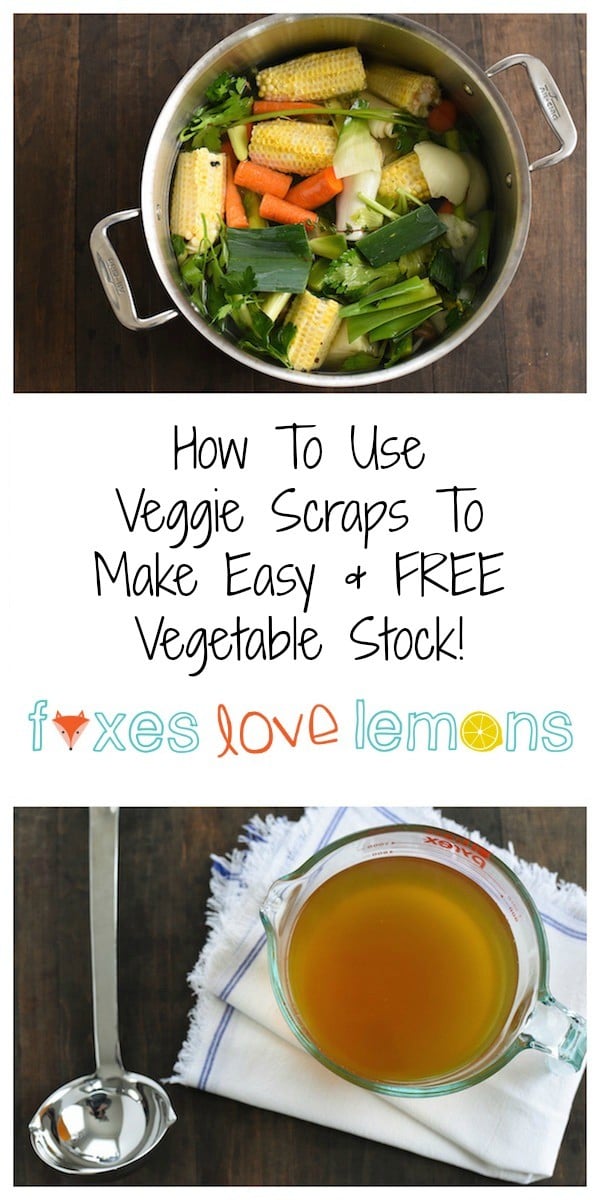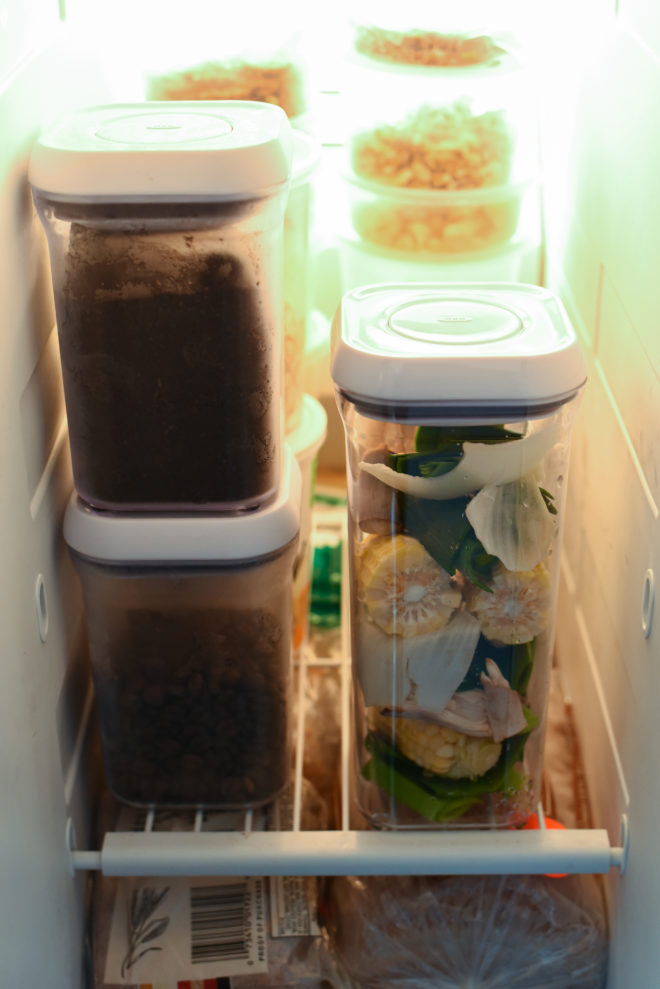Culinary School Lesson: Easy Vegetable Stock

In my “What I Learned in Culinary School” series, I’ll be sharing tips and tricks that I learned from two years of working with some of the country’s best chefs.
This will include big things like learning to work efficiently, and small things like how to cook bacon perfectly.
All of them will be applicable to your home kitchen, making you a faster, better, and more confident cook.
It’s just a guess, but I’m betting that vegetable consumption across the U.S. is at an all-time high each January. But with eating lots of veggies, comes lots of veggie scraps.
I always strive to reduce food waste in my kitchen, so instead of throwing those scraps in the garbage, I use them to make delicious homemade vegetable stock.

I first started making stock in culinary school, as my school processed hundreds of pounds of veggies (and scraps) a day.
There was always an industrial-sized batch of stock in the works. It was simple to take what I learned in school and adapt it for home use.
How to Save Scraps – I happened to have an extra pop-top container laying around, so I put that to use. Of course, a zip-top bag works just as well.
I keep my scraps in the freezer, then just add to them as I cook dinner each night.
What to Save? There are SO many scraps that make for great stock, but here’s the ones that turn up most frequently in my household:
- Outer layers of onions – While I don’t save onion skins as they often retain quite a bit of dirt, I do save the outer layers of onion flesh for stock. You know, those layers that are kind of tough that don’t make for great eating.
- Dark green parts of leeks – Ever notice that 99% of recipes that call for leeks call for “the white and light green parts only”? Ummm hello, leeks are expensive, and throwing away half of it (the dark green part) breaks my heart. Into the stock bin they go!
- Corn cobs – OK, so maybe not the ones that people have gnawed on at a barbecue. Just the ones you’ve cut the kernels off of.
- Mushroom stems – Making a recipe that calls for just the mushroom caps (oh hey, stuffed mushrooms)? The stems have SO much flavor – put them in the stock bin.
- Celery and carrot leaves – These aren’t really part of my regular diet, so they go right into the stock bin.
- Veggie peels – This one is a judgement call. If a carrot or a parsnip has REALLY dirty skin, and looks musty even after a good scrub, I won’t save the peels, as they’ll give the stock a muddy flavor. But if the peels are pretty clean, game on.

What Not to Save? While most everything is fair game, there are a few things that aren’t optimal for stock.
- Moldy or rotten vegetables – While vegetables that are just a little bit past their prime (such as bendy celery) are fine, if anything is REALLY old and looks terrible, it’s best just to introduce it to the garbage can or compost bin.
- Anything with a very strong, specific flavor (or color) – Cabbage, broccoli, artichokes and beets are a few examples.
How to Make Lazy Cook’s Stock, In which we throw everything into a pot, don’t measure anything, and it turns out fine. Who has time for measuring cups?
- Grab a big pot.
- The base of a good vegetable stock is carrot, celery and onion, so make sure these 3 ingredients are well represented, even if you have to add a few whole (chopped) vegetables to your scrap mix.
- Drop in all your precious scraps.
- Add some herbs – A few sprigs of parsley and thyme work well. Also, throw in a couple of bay leaves.
- Whole black peppercorns – Exactly 12. No, just kidding. A small palm full is sufficient.
- Garlic cloves – If you want. Don’t even bother chopping them. Just smash ’em and throw ’em in.
- Pour cold water over everything until water just barely covers the veggies.
- Simmer uncovered, over medium heat, at least 1 hour, but preferably 2.
- Strain stock through a fine-mesh strainer; discard solids.
- Use stock immediately for soup, poaching fish, risotto, savory oatmeal for dinner, or any vegetarian dish. Or, refrigerate stock up to 3 days or freeze up to 3 months.


I do include cabbage as part of my mix to make great vegetables stock! I find it gives great flavor profile on the side of very subtle sweetness if the stock I’m looking for needs to be on a mild flavor side. It doesn’t give off any color, nor a strong taste.
Great tip, Izikiia!
cool!
Hi Lori, I usually cook the vegetables until, either slightly baked in the broiler, or in a pot with a touch of vegetable oil or butter. This is the best way to extract all the flavors and aromas for our stok base.
Great tips, Andre!
California cooking school taught me that a good vegetable stock, built around the deep savory notes of bay and celery and the delicate sweetness of onion and carrot, is invaluable for giving body to many soups. You’ll also find it indispensable for stews, risottos, gratins and curries. Try to keep some of this in the freezer – though it can be rustled up in no time if you have the ingredients to hand.
Couldn’t agree more, Sam!